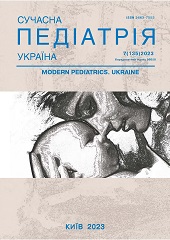Features of juvenile Rhupus syndrome with kidney damage: literature analysis and own experience
DOI:
https://doi.org/10.15574/SP.2023.135.136Keywords:
Rhupus syndrome, Overlap syndrome, juvenile idiopathic arthritis, systemic lupus erythematosus, secondary nephropathy, kidney damage, childrenAbstract
Rhupus syndrome is a rare coexistence of systemic lupus erythematosus (SLE) and rheumatoid arthritis (RA), characterized by symmetrical erosive polyarthritis and permanent deformities in addition to the clinical and serological features of SLE. Its prognosis is further complicated by neurological, and/or hematological, nephrological lesions, which sharply reduce the quality of life of patients. Clinical signs and consequences of Rhupus syndrome may differ in children and adults.
Purpose - to acquaint doctors with the peculiarities of diagnosis, treatment, and observation of children with Rhupus syndrome, the importance of early diagnosis of complicated courses and disabilities.
Clinical case. The authors present a clinical case of a 15-year-old girl with severe arthritis, which manifested simultaneously with clinical and serological signs of systemic lupus and developed secondary nephropathy at an early stage. JIA with the presence of specific autoantibodies to SLE in this case confirms the diagnosis of Rhupus. The child was treated with a disease-modifying antirheumatic drug (Methotrexate), steroids (Methylprednisolone), an angiotensin II receptor blocker, and other drugs in the treatment complex.
Conclusions. Accurate diagnosis is the key to the correct diagnosis and choice of treatment strategy, as Rhupus syndrome is a very rare disorder with a very limited number of reported cases, but with the early realization of possible complications, such as kidney damage.
The research was carried out in accordance with the principles of the Helsinki Declaration. The study protocol was approved by the Local Ethics Committee of the participating institution. The informed consent of the patient was obtained for conducting the studies.
No conflict of interests was declared by the authors.
References
Amezcua-Guerra LM, Springall R, Marquez-Velasco R, Gómez-García L, Vargas A, Bojalil R. (2006). Presence of antibodies against cyclic citrullinated peptides in patients with 'rhupus': A cross-sectional study. Arthritis Res Ther. 8(5): R144. https://doi.org/10.1186/ar2036; PMid:16934155 PMCid:PMC1779435
Amezcua-Guerra LM. (2009). Overlap between systemic lupus erythematosus and rheumatoid arthritis: Is it real or just an illusion? J Rheumatol. 36(1): 04-06. https://doi.org/10.3899/jrheum.081067; PMid:19208528
Bazsó A, Sevcic K, Orbán I, Poór G, Balogh Z, Kiss E. (2011). Overlapping juvenile idiopathic arthritis and systemic lupus erythematosus: a case report. Rheumatology International. 31(5): 695-698. https://doi.org/10.1007/s00296-010-1594-z; PMid:20676642
Beck LH, Salant DJ. (2013). Causes and diagnosis of membranous nephropathy. UpToDate B, DS (Ed), editor: UpToDate, Waltham, MA.
Benavente EP, Paira SO. (2011). Rhupus: Report of 4 cases. Rheumatol Clin. 7(5): 333-335. https://doi.org/10.1016/j.reumae.2010.12.003
Bennett R. (2017). Overlap syndromes. Kelley's Textbook of Rheumatology, 9th ed.: 1431-1448. https://doi.org/10.1016/B978-1-4377-1738-9.00086-4
Cavalcante EG, Aikawa NE, Lozano RG, Lotito AP, Jesus AA, Silva CA. (2011). Chronic polyarthritis as the first manifestation of juvenile systemic lupus erythematosus patients. Lupus. 20(9): 960-964. https://doi.org/10.1177/0961203311400113; PMid:21636626
Fernández A, Quintana G, Rondón F, Restrepo JF, Sánchez A, Matteson EL et al. (2006). Lupus arthropathy: A case series of patients with rhupus. Clin Rheumatol. 25(2): 164-167. https://doi.org/10.1007/s10067-005-1149-y; PMid:15980935
Iaccarino L, Gatto M, Bettio S, Caso F, Rampudda M, Zen M et al. (2013). Overlap connective tissue disease syndromes. Autoimmun Rev. 12(3): 363-373. https://doi.org/10.1016/j.autrev.2012.06.004; PMid:22743033
Li J, Wu H, Huang X, Xu D, Zheng W, Zhao Y et al. (2014). Clinical analysis of 56 patients with Rhupus syndrome: Manifestations and comparisons with systemic lupus erythematosus: A retrospective case-control study. Medicine (Baltimore). 93(10): e49. https://doi.org/10.1097/MD.0000000000000049; PMid:25170930 PMCid:PMC4616332
Radford MG Jr, Holley KE, Grande JP, Larson TS, Wagoner RD, Donadio JV et al. (1996). Reversible membranous nephropathy associated with the use of nonsteroidal anti-inflammatory drugs. JAMA. 276(6): 466-469. https://doi.org/10.1001/jama.276.6.466; PMid:8691554
Simon JA, Granados J, Cabiedes J, Morales JR, Varela JA. (2002). Clinical and immunogenetic characterization of Mexican patients with 'rhupus'. Lupus. 11(5): 287-292. https://doi.org/10.1191/0961203302lu189oa; PMid:12090562
Solis Cartas U, Martínez Larrarte JP, Prada Hernández DM, Gómez Morejón JA, Valdés González JL, Molinero Rodríguez C. (2017). Rhupus syndrome. A rare combination. Rev Colomb Reumatol. 24(4): 237-241. https://doi.org/10.1016/j.rcreue.2017.05.004
Tani C, D'Aniello D, DelleSedie A, Carli L, Cagnoni M, Possemato N et al. (2013). Rhupus syndrome: Assessment of its prevalence and its clinical and instrumental characteristics in a prospective cohort of 103 SLE patients. Autoimmun Rev. 12(4): 537-541. https://doi.org/10.1016/j.autrev.2012.09.004; PMid:23063507
Zhao XJ, Wei T, Dong B, Jia Y, Wang M. (2015). Renal damage caused by Rhupus syndrome associated with anti-neutrophil cytoplasmic antibodies vasculitis and cryoglobulinemia. Beijing Da Xue Xue Bao Yi Xue Ban. 47(5): 870-874.
Ziaee V, Moradinejad MH, Bayat R. (2013). RHUPUS syndrome in children: A case series and literature review. Case Rep Rheumatol: 1-4. https://doi.org/10.1155/2013/819629; PMid:23762733 PMCid:PMC3671282
Downloads
Published
Issue
Section
License
Copyright (c) 2023 Modern pediatrics. Ukraine

This work is licensed under a Creative Commons Attribution-NonCommercial 4.0 International License.
The policy of the Journal “MODERN PEDIATRICS. UKRAINE” is compatible with the vast majority of funders' of open access and self-archiving policies. The journal provides immediate open access route being convinced that everyone – not only scientists - can benefit from research results, and publishes articles exclusively under open access distribution, with a Creative Commons Attribution-Noncommercial 4.0 international license (СС BY-NC).
Authors transfer the copyright to the Journal “MODERN PEDIATRICS. UKRAINE” when the manuscript is accepted for publication. Authors declare that this manuscript has not been published nor is under simultaneous consideration for publication elsewhere. After publication, the articles become freely available on-line to the public.
Readers have the right to use, distribute, and reproduce articles in any medium, provided the articles and the journal are properly cited.
The use of published materials for commercial purposes is strongly prohibited.

